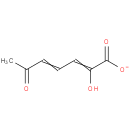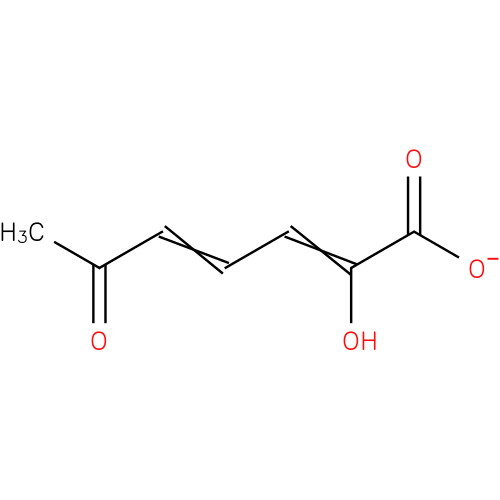|
Record Information |
|---|
| Version |
1.0 |
|---|
| Update Date |
1/22/2018 11:54:54 AM |
|---|
|
Metabolite ID | PAMDB100025 |
|---|
|
Identification |
|---|
| Name: |
2-hydroxy-6-oxo-2,4-heptadienoate |
|---|
| Description: | A 6-oxo monocarboxylic acid anion that is the conjugate base of 2-hydroxy-6-oxo-2,4-heptadienoic acid, obtained by deprotonation of the carboxy group. Major species at pH 7.3. |
|---|
|
Structure |
|
|---|
| Synonyms: | - 2-hydroxy-6-keto-2,4-heptadienoate
- 2-hydroxy-6-ketohepta-2,4-dienoate
- 2-hydroxy-6-oxo-2,4-heptadienoate
|
|---|
|
Chemical Formula: |
C7H7O4 |
|---|
| Average Molecular Weight: |
155.128 |
|---|
| Monoisotopic Molecular
Weight: |
155.034 |
|---|
| InChI Key: |
HVZGWILTESYJSP-UHFFFAOYSA-M |
|---|
| InChI: | InChI=1S/C7H8O4/c1-5(8)3-2-4-6(9)7(10)11/h2-4,9H,1H3,(H,10,11)/p-1 |
|---|
| CAS
number: |
Not Available |
|---|
| IUPAC Name: | 2-hydroxy-6-oxohepta-2,4-dienoate |
|---|
|
Traditional IUPAC Name: |
Not Available |
|---|
| SMILES: | OC(=CC=CC(=O)C)C([O-])=O |
|---|
|
Chemical Taxonomy |
|---|
|
Taxonomy Description | This compound belongs to the class of organic compounds known as medium-chain keto acids and derivatives. These are keto acids with a 6 to 12 carbon atoms long side chain. |
|---|
|
Kingdom |
Organic compounds |
|---|
| Super Class | Organic acids and derivatives |
|---|
|
Class |
Keto acids and derivatives |
|---|
| Sub Class | Medium-chain keto acids and derivatives |
|---|
|
Direct Parent |
Medium-chain keto acids and derivatives |
|---|
| Alternative Parents |
|
|---|
| Substituents |
- Medium-chain keto acid
- Fatty acyl
- Unsaturated fatty acid
- Acryloyl-group
- Enone
- Alpha,beta-unsaturated ketone
- Ketone
- Carboxylic acid derivative
- Carboxylic acid
- Enolate
- Monocarboxylic acid or derivatives
- Organic oxide
- Carbonyl group
- Hydrocarbon derivative
- Organic oxygen compound
- Organooxygen compound
- Organic anion
- Aliphatic acyclic compound
|
|---|
| Molecular Framework |
Aliphatic acyclic compounds |
|---|
| External Descriptors |
- a small molecule (CPD-8782)
|
|---|
|
Physical Properties |
|---|
| State: |
Not Available |
|---|
| Charge: | -1 |
|---|
|
Melting point: |
Not Available |
|---|
| Experimental Properties: |
Not Available |
|---|
| Predicted Properties |
|
|---|
|
Biological Properties |
|---|
| Cellular Locations: |
Not Available |
|---|
| Reactions: | |
|---|
|
Pathways: |
|
|---|
|
Spectra |
|---|
| Spectra: |
Not Available |
|---|
|
References |
|---|
| References: |
- Fujiwara M, Golovleva LA, Saeki Y, Nozaki M, Hayaishi O. Extradiol cleavage of
3-substituted catechols by an intradiol dioxygenase, pyrocatechase, from a
Pseudomonad. J Biol Chem. 1975 Jul 10;250(13):4848-55. Pubmed: 238971
|
|---|
| Synthesis Reference: |
Not Available |
|---|
| Material Safety Data Sheet (MSDS) |
Not Available |
|---|
|
Links |
|---|
| External Links: |
|
|---|


